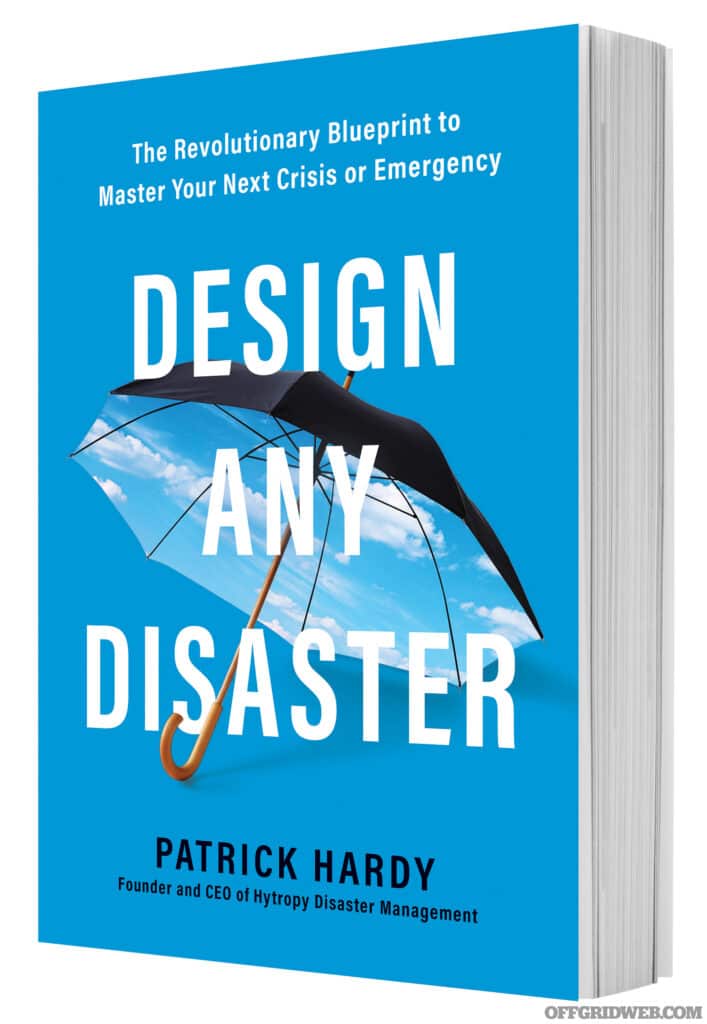RECOIL OFFGRID Preparation Book Review: Design Any Disaster
In This Article
Disasters are complex crises that reveal the type of person we truly are and serve as proving grounds to learn who we wish to become. In Design Any Disaster, author Patrick Hardy takes what we commonly think we know about disaster preparedness and formulates a plan that reinvents the principle of how we respond to emergencies on all scales.
Through his C3 method (Command, Communicate, Carry Out), Hardy looks to change how we view ourselves to ensure we aren’t helpless bystanders who allow ourselves to become victims to the disaster, but capable leaders who are willing to protect ourselves and families. The entire premise of the book is that disasters don’t have to be calamitous events that disrupt our lives, but that we are the determinant of whether an unexpected event becomes a disaster in the first place.
Design Any Disaster prompts us to look at our role in disasters differently as both the trained and untrained. While the book hits home for the average citizen, it offers a different take on preparedness for the seasoned veteran. The notion that Hardy presents, “Never experience a disaster again … ever,” is a surefire way for curious readers to pull the trigger on purchasing his book. If not for Hardy’s background in emergency management, one might think that he’d be out of touch from reality.
That, however, is Hardy’s point. He has taken the status quo and made it relatable to the average reader, empowering them to take action and turn any disaster to their will. Hardy utilizes his C3 method to ensure each disaster is approached the same way, giving his readers foresight into mentally preparing for, and responding to, any crisis. Instructing his readers how to React, Respond, and Recover for each scenario is the foundation of his theory, and even includes a method to Reverse disaster by gaining valuable insight into how to become a more complete person after the disaster is over.
The issue with Design Any Disaster is that it’s difficult to interpret who the book is written for. If written for those who are inexperienced with disaster preparation, readers would be in for a treat as they feel they’re privy to revolutionary teaching. For those who are experienced in emergency management, the book seems to be a repackaging of information that already exists. This isn’t to say anything Hardy writes is wrong; his approach is spot-on and should be a refresher for those who have worked in the field for some time.
Any long-term government worker would agree with Hardy that 99 percent of disaster plans fail because they’re convoluted messes that are rarely followed through, and that our reliance on disaster equipment actually leaves us less prepared. But ask any self-reliant prepper out there and they would’ve told you the same information three decades ago, so the information that’s presented isn’t really new.
It’s very much appreciated that Hardy calls out these mistakes, but again, the tactics presented are a rejuvenated reminder that our best asset in a disaster lies between our ears. Hardy does a wonderful job at spicing up the essentials of how disaster preparedness should look, formulating a solid plan for those new to the field to start their journey. It’s just not for the seasoned prepper.
Design Any Disaster, while exploring the common-sense side of disaster preparedness, is a different take on how we think about our levels of readiness and reaction during a crisis. Hardy’s point is that if we’re going to act, then prepare to act. We should never allow our circumstances to turn us into bystanders while someone else determines our survival. We do this through his approach called the C3 method. None of this, however, is revolutionary, and this is where Hardy’s work could lose the interest of more seasoned veterans in disaster survival.
If you’re new to disaster preparedness, I’d highly recommend this book. It’s a valuable tool to help in any disaster-related scenario and should find its place amongst a library of other material for those looking to protect themselves and families. If you’ve been in the field for a while and feel that you’ve been gaining ground in your disaster prepping efforts, then Design Any Disaster might be a fresh set of eyes to revitalize your passion for all things preparedness.
If you’ve been around the block a few times, however, and have a year-long supply of food in your four-bedroom underground disaster bunker, this may not be the book for you. At the end of the day, Hardy is developing a larger audience, and this could be an attempt to reach the more seasoned reader, challenging us to not be bystanders, but to share our own wisdom to a new generation of preppers in a world quickly going mad. Maybe we all are a bit stagnant and could use a strong refresher at what it means to be prepared, but the information within the book is far from “revolutionary” and feels more like a new coat of paint to spice up old information.

Book & Author
Design Any Disaster: The Revolutionary Blueprint to Master Your Next Crisis or Emergency

By Patrick Hardy
Publisher
MSRP
$30
URL
Pages
288
Rating
Thrive
>Survive
Die
Don't forget to subscribe to Recoil Offgrid's free newsletter for more content like this.
 STAY SAFE: Download a Free copy of the OFFGRID Outbreak Issue
STAY SAFE: Download a Free copy of the OFFGRID Outbreak Issue
No Comments